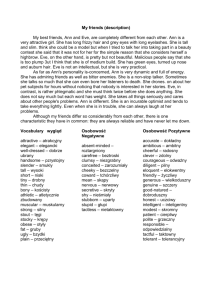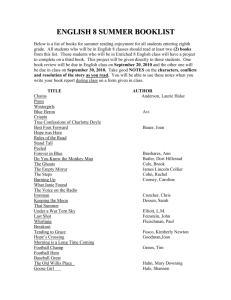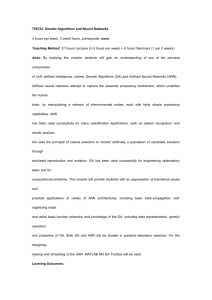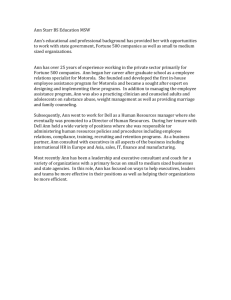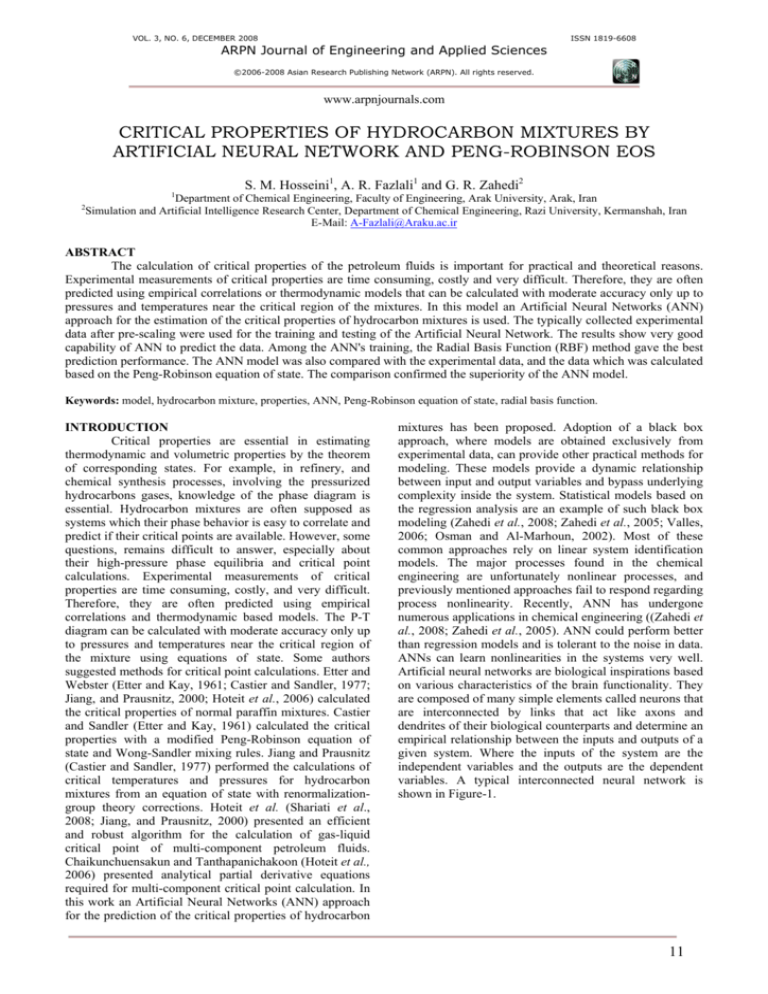
VOL. 3, NO. 6, DECEMBER 2008
ISSN 1819-6608
ARPN Journal of Engineering and Applied Sciences
©2006-2008 Asian Research Publishing Network (ARPN). All rights reserved.
www.arpnjournals.com
CRITICAL PROPERTIES OF HYDROCARBON MIXTURES BY
ARTIFICIAL NEURAL NETWORK AND PENG-ROBINSON EOS
1
S. M. Hosseini1, A. R. Fazlali1 and G. R. Zahedi2
Department of Chemical Engineering, Faculty of Engineering, Arak University, Arak, Iran
Simulation and Artificial Intelligence Research Center, Department of Chemical Engineering, Razi University, Kermanshah, Iran
E-Mail: A-Fazlali@Araku.ac.ir
2
ABSTRACT
The calculation of critical properties of the petroleum fluids is important for practical and theoretical reasons.
Experimental measurements of critical properties are time consuming, costly and very difficult. Therefore, they are often
predicted using empirical correlations or thermodynamic models that can be calculated with moderate accuracy only up to
pressures and temperatures near the critical region of the mixtures. In this model an Artificial Neural Networks (ANN)
approach for the estimation of the critical properties of hydrocarbon mixtures is used. The typically collected experimental
data after pre-scaling were used for the training and testing of the Artificial Neural Network. The results show very good
capability of ANN to predict the data. Among the ANN's training, the Radial Basis Function (RBF) method gave the best
prediction performance. The ANN model was also compared with the experimental data, and the data which was calculated
based on the Peng-Robinson equation of state. The comparison confirmed the superiority of the ANN model.
Keywords: model, hydrocarbon mixture, properties, ANN, Peng-Robinson equation of state, radial basis function.
INTRODUCTION
Critical properties are essential in estimating
thermodynamic and volumetric properties by the theorem
of corresponding states. For example, in refinery, and
chemical synthesis processes, involving the pressurized
hydrocarbons gases, knowledge of the phase diagram is
essential. Hydrocarbon mixtures are often supposed as
systems which their phase behavior is easy to correlate and
predict if their critical points are available. However, some
questions, remains difficult to answer, especially about
their high-pressure phase equilibria and critical point
calculations. Experimental measurements of critical
properties are time consuming, costly, and very difficult.
Therefore, they are often predicted using empirical
correlations and thermodynamic based models. The P-T
diagram can be calculated with moderate accuracy only up
to pressures and temperatures near the critical region of
the mixture using equations of state. Some authors
suggested methods for critical point calculations. Etter and
Webster (Etter and Kay, 1961; Castier and Sandler, 1977;
Jiang, and Prausnitz, 2000; Hoteit et al., 2006) calculated
the critical properties of normal paraffin mixtures. Castier
and Sandler (Etter and Kay, 1961) calculated the critical
properties with a modified Peng-Robinson equation of
state and Wong-Sandler mixing rules. Jiang and Prausnitz
(Castier and Sandler, 1977) performed the calculations of
critical temperatures and pressures for hydrocarbon
mixtures from an equation of state with renormalizationgroup theory corrections. Hoteit et al. (Shariati et al.,
2008; Jiang, and Prausnitz, 2000) presented an efficient
and robust algorithm for the calculation of gas-liquid
critical point of multi-component petroleum fluids.
Chaikunchuensakun and Tanthapanichakoon (Hoteit et al.,
2006) presented analytical partial derivative equations
required for multi-component critical point calculation. In
this work an Artificial Neural Networks (ANN) approach
for the prediction of the critical properties of hydrocarbon
mixtures has been proposed. Adoption of a black box
approach, where models are obtained exclusively from
experimental data, can provide other practical methods for
modeling. These models provide a dynamic relationship
between input and output variables and bypass underlying
complexity inside the system. Statistical models based on
the regression analysis are an example of such black box
modeling (Zahedi et al., 2008; Zahedi et al., 2005; Valles,
2006; Osman and Al-Marhoun, 2002). Most of these
common approaches rely on linear system identification
models. The major processes found in the chemical
engineering are unfortunately nonlinear processes, and
previously mentioned approaches fail to respond regarding
process nonlinearity. Recently, ANN has undergone
numerous applications in chemical engineering ((Zahedi et
al., 2008; Zahedi et al., 2005). ANN could perform better
than regression models and is tolerant to the noise in data.
ANNs can learn nonlinearities in the systems very well.
Artificial neural networks are biological inspirations based
on various characteristics of the brain functionality. They
are composed of many simple elements called neurons that
are interconnected by links that act like axons and
dendrites of their biological counterparts and determine an
empirical relationship between the inputs and outputs of a
given system. Where the inputs of the system are the
independent variables and the outputs are the dependent
variables. A typical interconnected neural network is
shown in Figure-1.
11
VOL. 3, NO. 6, DECEMBER 2008
ISSN 1819-6608
ARPN Journal of Engineering and Applied Sciences
©2006-2008 Asian Research Publishing Network (ARPN). All rights reserved.
www.arpnjournals.com
Figure-1. A typical interconnected neural network.
In this Figure an input layer, a central or hidden
layer and an output layer can be seen. In a network each
connecting line has an associated weight. Two important
abilities of neural network (NN) are supplying fast
answers to a problem and capability of generalizing
answers, providing acceptable results for unknown
samples. In this way, they should learn about the problem
under study and this step is commonly named training
process. One of the well-known topologies of neural
networks for learning is the Multi-Layer Perceptron
(MLP), which is used for classification and estimation
problems. These Artificial neural networks are trained by
adjusting the input weights (connection weights) by some
algorithm so that the calculated outputs approximate the
desired outputs (Zahedi et al., 2008; Zahedi et al., 2005).
The output from a given neuron is calculated by applying
a transfer function to a weighted summation of its input to
give an output, which can serve as input to other neurons
as follows:
pj = f ( ∑ wij aj )
(i = 0,…, L)
(1)
In this topology, there are L inputs, m hidden
unit, and n output units. Where wij is weight going from
input i to hidden unit j. using activation function f, and the
output of neuron j is pj.
Sigmoid activation functions are of common
interest. Sigmoid tangential and other functions could be
applied in ANN modeling (Zahedi et al., 2008; Zahedi et
al., 2005 and Valles, 2006). ANN training is an
optimization process in which an error function is
minimized by adjusting the ANN weights. When an input
training pattern is introduced to the ANN, it calculates an
output. Output is compared with the real output provided
by the user. This difference is used by the optimization
technique to train the network. The typical performance
function that is used for training neural networks is the
Mean sum of Squares of the network Errors (MSE) which
is given by Eq. (2)
MSE = (1/n) ∑ (ti − hi) 2
(I = 1, n)
Where hi is the ith real target and ti is the network output
corresponding to the jth input. Thus, the training process is
a path from input layer to output layer to calculate an
output, obtaining error and a backward path to update the
weights. The procedure goes on until MSE is minimized.
During the training process, the train set error decreases
since the ANN weights are adjusted according to the
predicted errors from this set. The training process should
stop when the tasking error reaches its minimum value.
Besides MLP another class of networks has been known in
recent years called Radial Basis Function (RBF) network.
Like most feed forward networks, RBF networks have
three layers, namely an input layer, the hidden layer with
Gaussian activation function and output layer. The role of
input layer is to distribute the inputs to each of hidden
layer nodes. The weights on the links between the input
layer and the hidden layer are set to unit and remain
constant during training. Second layer or hidden layer
performs a fixed nonlinear transformation which maps the
input space onto a new space, the output layer then
implements a linear combination on this new space. The
network is solved by initially clustering the monitored
process data, calculating the predictive error between
experimental and network output. This continues until
prediction error for all the data in which are used for
training became minimum (Zahedi et al., 2005 and 2008).
Figure-2 shows a radial basis network with R inputs.
Figure-2. Radial basis network with R inputs.
Notice that the expression for the net work input
of a radial basis (radbas) neuron is different from that of
neurons in previous (i.e. MLP). Here the net work input to
the radbas transfer function is the vector distance between
its weight vector w and the input vector p, multiplied by
the bias b. (The box in this case accepts the input vector p
and the single row input weight matrix, and produces the
dot product of the two.)
The transfer function for a radbas neuron is:
Radbas (n) = exp (-n2)
(3)
Figure-3 shows a plot of the radbas transfer function.
(2)
12
VOL. 3, NO. 6, DECEMBER 2008
ISSN 1819-6608
ARPN Journal of Engineering and Applied Sciences
©2006-2008 Asian Research Publishing Network (ARPN). All rights reserved.
www.arpnjournals.com
that produces 1 whenever the input p is identical to its
weight vector p. The bias b allows the sensitivity of the
radbas neuron to be adjusted (Matlab software's toolbox).
THE EXPERIMENTAL DATA SET
To build an ANN for predicting of the Critical
properties of Hydrocarbon Mixtures, the experimental data
provided. The data sets were collected from seventeen
samples
typically
Hydrocarbon
Mixtures.
The
specifications of Hydrocarbon Mixture samples are shown
in Table-1 (Shariati et al., 2008; Etter and Kay, 1961;
Castier and Sandler, 1977; Jiang and Prausnitz, 2000;
Hoteit et al., 2006).
Figure-3. Plot of radbas transfer function.
The radbas function has a maximum of 1 when its
input is 0. As the distance between w and p decreases, the
output increases. Thus, a radbas neuron acts as a detector
Table-1. Compositions of multi component mixtures.
Mixture
No.
Sample1
N2
CH4
C2H6
C3H8
C4H10
C5H12
C6H14
C7H16
0
0
0.801
0
0
0.064
0
0.135
Sample 2
0
0
0.612
0
0
0.271
0
0.117
Sample 3
0
0
0.615
0
0
0.296
0
0.089
Sample 4
0
0
0.726
0
0.171
0
0
0.103
Sample 5
0
0
0.514
0
0.412
0
0
0.074
Sample 6
0.043
0.415
0
0.542
0
0
0
0
Sample 7
0.095
0.36
0
0.545
0
0
0
0
Sample 8
0.046
0.453
0
0.5005
0
0
0
0
Sample 9
0
0.833
0.130
0.035
0
0
0
0
Sample 10
0
0.800
0.039
0.161
0
0
0
0
Sample 11
0
0.4345
0.0835
0.4330
0
0
0
0
Sample 12
0
0.193
0.470
0
0.337
0
0
0
Sample 13
0
0.391
0.354
0
0.255
0
0
0
Sample 14
0
0.007
0.879
0
0.114
0
0
0
Sample 15
0
0.461
0.443
0
0
0.095
0
0
Sample 16
0
0.196
0.758
0
0
0.045
0
0
Sample 17
0
0
0.980
0.016
0.004
0
0
0
ANN applied for predicting the critical properties of
hydrocarbon mixtures
Inputs of a network should be selected carefully
if the best results are expected to be obtained. The input
variables should reflect the underlying physics of the
process to be analyzed.
Inputs for the network are compositions of multi
component mixtures, acentric factor, critical properties for
pure components, molecular weight of each component
average molecular weight and binary interaction
parameters between components; outputs are the critical
temperature, pressure and volume. Various architectures
of MLP and RBF are used to predict amount of Critical
properties of Hydrocarbon Mixtures. Each type of input
and output data were scaled by dividing to maximum
amount of that variable for scaling purpose. Each ANN
has been trained with (2/3) of data set and (1/3) of samples
have been used for testing the predictions of ANN. In the
first step, MLP architecture has been developed. The task
was finding the optimum number of nodes in the hidden
layer which provide good estimates of the outputs. The
criterion for selection was MSE between net work output
and training data. In the second step, RBF architecture was
adopted.
Table-2 shows a comparison between the
Performance of the RBF and the optimum MLP. As the
13
VOL. 3, NO. 6, DECEMBER 2008
ISSN 1819-6608
ARPN Journal of Engineering and Applied Sciences
©2006-2008 Asian Research Publishing Network (ARPN). All rights reserved.
www.arpnjournals.com
network trained with RBF architecture gives much better
results for training sets than the optimal MLP, it was used
for prediction of the critical Points of Hydrocarbon
Mixtures.
Table-2. Comparison of performance of optimum MLP
and RBF for testing the ANN.
Network type
MSE
Optimal MLP
1.042
RBF
4.73e-2
RESULTS OF MODELING WITH ANN
Figure-4 represents a sample comparison between
predicted data by the ANN model and the experimental
data which have not been used in training of the ANN (the
test data). As shown in this figure, RBF method is more
accurate than the other ANN structures. This is may cause
of clustering in RBF that eliminates uncorrelated data
from training process.
Figure-5. Plot of experimental data vs. predicted values
by ANN model.
Thermodynamic model applied to predicting the
critical properties of hydrocarbon mixtures
(Shariati et al., 2008)
The formation of a new phase is generally
preceded by some degree of super saturation. The bubble
nucleation in a liquid at a pressure below its bubble point
value can be inhibited to a large extent by expanding the
liquid gradually, avoiding fluid agitation, and ensuring the
lack of minute gas pockets in the liquid prior to the
expansion. Such systems are Meta stable with an energy
level which will be reduced by forming a new phase. The
calculation is performed base on Peng-Robinson equation
of state. This equation of state can be written as (Shariati
et al., 2008; Etter and Kay, 1961; Castier and Sandler,
1977; Jiang and Prausnitz, 2000; Hoteit et al., 2006).
Figure-4. Comparison of the measured data and ANN
results for RBF network class for critical point's
hydrocarbon mixtures.
It is obvious from this Figure that the ANN
provides results very close to process measurements. A
scatter plot of measured experimental data against the
ANN model predictions is shown in Figure-5. The
predictions which match measured values should fall on
the diagonal line. Almost all data lay on this line, which
confirms the accuracy of the ANN model.
RT
aα
−
V − b V 2 − 2bV − b 2
R 2Tc2
a = 0.45724
Pc
P=
b = 0.07780
( 4)
(5)
RTc
Pc
( 6)
α 0.5 = 1 + (1 − Tr0.5 )(0.37464 + 1.5422ω − 0.26992ω 2 )
(7)
The mixture parameters a and b is as follow (2):
b = ∑ y i bi
(8 )
( a α ) ij = (1 − k ij ) ( a α ) i ( a α ) j
(9 )
aα =
∑∑ y
i
y j ( a α ) ij
(10 )
Where P (bar) is pressure , R is Universal gas constant, T
(°K) is temperature , V (cm3/mol) is Molar volume, Tc is
Critical temperature, Pc is Critical pressure, Tr is Reduced
temperature, ω is acentric factor, yi is Mole fraction of
14
VOL. 3, NO. 6, DECEMBER 2008
ISSN 1819-6608
ARPN Journal of Engineering and Applied Sciences
©2006-2008 Asian Research Publishing Network (ARPN). All rights reserved.
www.arpnjournals.com
component i, bi is Co volume of component i and kij is
Binary interaction parameter.
Critical volume
For each mixture, first the metastable points are
calculated using PR EOS. For this purpose, at each certain
temperature, the volumes vmin, and vmax are obtained by
solving the derivative ( ∂ P / ∂ V ) T = 0
At vmin the pressure has its minimum value in which the
single liquid phase exist (at metastable condition) and at
vmax the pressure has its maximum value in which the
single vapor phase exist (at metastable condition). Then by
extrapolating of the metastable volumes and solution of
the following equations, the critical volume can be
calculated (Shariati et al., 2008; Etter and Kay, 1961;
Castier and Sandler, 1977; Jiang, and Prausnitz, 2000;
Hoteit et al., 2006):
2
3
V = exp(a1 + b1Vmin + c1Vmin
+ d1Vmin
)
(11)
2
V = exp(a2 + b2Vmax + c2Vmax
)
(12)
c
c
Critical temperature
For prediction of critical temperature, the
metastable concepts, is used. For this method, the best
equation for prediction of critical temperature as a
function of metastable maximum volume is (Shariati et al.,
2008; Etter and Kay, 1961; Castier and Sandler, 1977;
Jiang and Prausnitz, 2000; Hoteit et al., 2006):
T c = f (Vmax )
T c = a3 + b3 ln V max
(13)
By using of critical volume that calculated in the previous
step, the critical temperature can be calculated.
Critical pressure
The critical pressure of a multi component
mixture of hydrocarbons is calculated by the following
equation (Shariati et al., 2008; Etter and Kay, 1961;
Castier and Sandler, 1977; Jiang and Prausnitz, 2000;
Hoteit et al., 2006):
Pc mix = Pc , cal + ∑ φi ( yi )
(14)
Where Pc,cal is the critical pressure of the mixture that was
calculated from extrapolating the Pmin and Pmax of the
metastable points obtained for each isotherm till they cross
each other. Also
∑φ ( y )
i
i
is the total excess critical
pressure and is equal to the sum of the contributions of the
excess critical pressure of the components, except the
heaviest.
Comparison of experimental data with ANN and
thermodynamic model results
Good performance of ANN is obvious when it is
compared to other prediction models and experimental
data. To check the performance of the ANN model, its
estimations are compared with thermodynamic model base
on PR EOS. Results carried out with the thermodynamic
model were compared with ANN and also the
experimental data which were not used in training of the
ANN. Tables 3 and 4 also compares the error of both
ANN and thermodynamic model. The prepared ANN
model can be updated where new data are available. This
task is applicable by retraining ANN using old ANN
weights as initial weights for the new ANN. The ANN can
be used to plan and control the operation of industrial oil.
Optimization tasks can be carried out easily by the ANN
model. The network will provide the outputs which
represent the optimum condition for the prediction of
critical properties of hydrocarbon mixtures.
Table-3. Comparison between the sample values of critical properties obtained from ANN models
and thermodynamic model and the experimental data.
A sample of critical properties of hydrocarbon mixtures
EXP
Tc (°K) = 394.71
3
Vc (cm /mol) = 139.36
ANN Model
Thermodynamic
model
% Error for
ANN model
394.64
393.4617
0.0177
% Error for
Thermodynamic
model
0.316
139.30
142.06
0.0430
2.36
Table-4. Comparison's performance of the ANN and
thermodynamic model by the minimum square error.
Model Type
MSE
ANN model
0.0473
Thermodynamic model
3.8324
CONCLUSIONS
In this model, the ability of ANN in the modeling
and prediction of the critical properties of hydrocarbon
mixtures has been investigated. Specifically, the critical
properties of hydrocarbon mixtures in the specific sample
were modeled with RBF and MLP neural network
architectures. By using RBF topology good agreement
with experimental data was obtained. An important feature
of the model is that, doesn't require any theoretical
knowledge or human experience during the training
process. So prior knowledge hasn’t been used and the
model has been trained based on the experimental data
only. All unknown relationships have been represented
with ANN, which can approximate instead of traditional
15
VOL. 3, NO. 6, DECEMBER 2008
ISSN 1819-6608
ARPN Journal of Engineering and Applied Sciences
©2006-2008 Asian Research Publishing Network (ARPN). All rights reserved.
www.arpnjournals.com
relationships. ANN models could be used instead of
correlations in thermodynamic modeling by noting their
application ranges. The ability of network could be
extended to generate data in longer periods. In spite of this
Limitation, ability of ANN in generation of data is
excellent. In our approach minimum experimentation is
necessary and this is a way to produce data with minimum
time and cost.
Asphaltene precipitation and comparison it with FloryHuggins model in crude oil. The 5th international congress
on chemical engineering, Kish Island, Iran.
Shariati A., Mostafazadeh A. K., Bahramipibazari B.A.
2007. Calculation of Critical Points of Hydrocarbon
Mixtures Using Metastability Concept. The first Iranian
conference of thermodynamics, Isfahan University,
Isfahan, Iran.
Nomenclature
a
Attractive parameter of cubic EOS
ai
Attractive parameter of component i
b
Co volume
bi
Co volume of component i
calc
Calculated
EoS
Equation of state
Exp
Experimental
kij
Binary interaction parameter
P
Pressure
Pc
Critical pressure
PR
Peng-Robinson
R
Universal gas constant
T
Temperature
Tc
Critical temperature
Tr
Reduced temperature
V
Molar volume
Vc
Critical molar volume
Vmax
Maximum metastable molar volume
Vmin
Minimum metastable molar volume
yi
Mole fraction of component i
ω
Acentric factor
α
Temperature-dependent parameter in Eos
ANN
Artificial neural network
MSE
Mean square error
RBF
Radial basis function
Wij
Weight
MLP
Multi layer percpetron
f
Activation function
t
Target value
h
Real value
REFERENCES
Zahedi G.R., Fazlali A.R., Hosseini S.M., Pazuki G.R.
2008. A Neural Network Approach for Prediction of
Zahedi G.R,.Jahanmiri A., Rahimpor M.R. 2005. A Neural
Network Approach for Prediction of the CuO-ZnO-Al2O3
Catalyst Deactivation. International Journal of Chemical
Reactor Engineering. Volume 3.
Vales H.R. 2006. A neural network method to predict
activity coefficients for binary systems based on molecular
functional group contribution. M.S. Thesis. University of
PUERTO RICO.
Etter D.O. and Kay W.B. 1961. Critical properties of
mixtures of normal paraffin hydrocarbons. Journal of
Chemical and Engineering Data. Vol. 6, No. 3.
Castier M.and Sandler S.Ι. 1977. Critical points with the
Wong-Sandler mixing rule- ΙΙ. Calculations with a
modified Peng-Robinson equation of state. Chemical
Engineering Science. 52(20): 3579-3588.
Jiang J. and Prausnitz J.M. 2000. Critical temperatures and
pressures for hydrocarbon mixtures from an equation of
state with renormalization-group theory corrections. Fluid
Phase Equilibria. p. 169.
Hoteit H., Santiso E. and Firoozabadi A. 2006. An
efficient and robust algorithm for the calculation of gasliquid critical point of multicomponent petroleum fluids.
Fluid Phase Equilibria. p. 241.
Osman E.A., Al-MArhoun M.A. 2002. Using artificial
neural networks to develop new PVT correlations for
Saudi crude oils. 10th Abu Dhabi International Petroleum
exhibition and conference. October.
Fazlali A.R, Hosseini .S.M and Khosrobeigi. E. 2007. A
New thermodynamic modified Flory-Huggins model for
prediction of asphaltene precipitation in crude oil.
International Conference on mining, materials and
petroleum engineering. Phuket, Thailand. May. pp. 10-12.
Ganguly S. 2003. Prediction of VLE data using radial
basis function network. Computers and chemical
engineering. 27: 1445-1454.
Sozen A., Arcakilioglu E., Ozalp M. 2004. Investigation
of thermodynamic properties of refrigerant/absorbent
couples using artificial neural networks. Chemical
engineering and processing. 43: 1253-1264.
16
VOL. 3, NO. 6, DECEMBER 2008
ISSN 1819-6608
ARPN Journal of Engineering and Applied Sciences
©2006-2008 Asian Research Publishing Network (ARPN). All rights reserved.
www.arpnjournals.com
Suoqi Zhao, Zhiming Xu, Chunming Xu, Keng H. Chung.
2004. Feedstock characteristic index and critical properties
of heavy crudes and petroleum residua. Journal of
Petroleum Science and Engineering. p. 41.
Zhang Jianzhong, Zhao Suoqi, Wang Renan, Yang
Guanghua. 1998. Prediction of critical properties of nonpolar compounds, petroleum and coal-tar liquids. Fluid
Phase Equilibria. p. 149.
Mohammad R. Riazi, Taher A. Al-Sahhaf, Mutlaq A. AlShammari. 1998. A generalized method for estimation of
critical constants. Fluid Phase Equilibria. p. 147.
17




